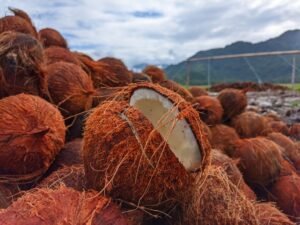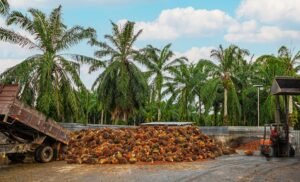
The Impact of Rainfall and Monsoon
on Coconut Export Volume

Monsoon Rains and Their Role in Coconut Farming
Coconut farming is one of India’s most vital agricultural sectors, supporting millions of farmers and fueling international trade. The country is among the largest producers of coconuts in the world, with exports reaching markets in Asia, the Middle East, Europe, and beyond. However, one natural factor has a greater influence than any other on this crop’s success: the monsoon.
The connection between monsoon and coconut harvest is direct and undeniable. A strong monsoon season brings abundant water, ensuring healthy palm growth and a high coconut yield that India can depend on. On the other hand, weak or irregular rainfall can reduce production, creating challenges in maintaining a steady coconut export volume. This makes the monsoon not just a seasonal event but a decisive factor in the global coconut supply chain.
The connection between monsoon and coconut harvest is direct and undeniable. A strong monsoon season brings abundant water, ensuring healthy palm growth and a high coconut yield that India can depend on. On the other hand, weak or irregular rainfall can reduce production, creating challenges in maintaining a steady coconut export volume. This makes the monsoon not just a seasonal event but a decisive factor in the global coconut supply chain.
Why Monsoon Matters for Coconut Farming
The coconut palm thrives in tropical climates, requiring consistent rainfall and sunlight. In India, where a majority of plantations are concentrated in states like Kerala, Tamil Nadu, Karnataka, and Andhra Pradesh, the southwest and northeast monsoons together provide the lifeline for cultivation.
- Water Dependency: Coconut palms need well-distributed rainfall of 1,500–2,500 mm annually. Monsoon rains supply this naturally.
- Fruit Development: Adequate rainfall ensures nut setting and proper kernel development, directly affecting export-grade coconuts.
- Regional Influence: Kerala receives abundant monsoon showers, often resulting in higher yields, while Tamil Nadu depends on the northeast monsoon, making its crop more vulnerable to delays.
In simple terms, the health of the monsoon determines the health of the harvest, and in turn, the coconut export volume available for international trade.
Seasonal Variations in Coconut Yield
Coconut trees follow a natural fruiting cycle, but their productivity is heavily influenced by rainfall. When the monsoon is strong, plantations witness a surge in output, while weak monsoons bring coconut supply fluctuations.
- Good Monsoon Years: Higher nut production, fuller kernels, and more consistent size and quality, making exports reliable.
- Poor Monsoon Years: Reduced yield, smaller coconuts, and sometimes gaps in supply that affect both domestic and export markets.
- Seasonal Crop Yield India: Farmers often align their harvesting schedules with post-monsoon seasons when yields are highest, ensuring better volume and quality.
Thus, while the monsoon dictates the availability of coconuts in local markets, its larger impact is felt in the global supply chain, where India plays a leading role.
Impact on Coconut Export Volume
The availability of coconuts for international buyers directly depends on surplus harvest after meeting domestic needs. In years of strong rainfall, exporters enjoy higher trade opportunities, while poor monsoons may reduce coconut export volume significantly.
- Export Quality: Higher rainfall improves kernel thickness and water content, qualities preferred in global markets.
- Export Challenges: Low yield forces suppliers to either reduce shipment sizes or source from multiple regions to fulfill contracts.
- Market Dynamics: Coconut supply fluctuations often lead to price variations, making export planning more complex.
For international buyers, this means that the success of their coconut imports is often linked to the rhythm of India’s monsoons.
How Exporters Manage Seasonal Challenges
Despite being highly dependent on natural rainfall, exporters and suppliers of coconuts adopt various strategies to ensure a steady flow to international markets. One key approach is diversified sourcing; by procuring coconuts from multiple states, they minimize the risk of a regional shortfall. Additionally, the use of storage and preservation techniques allows for husked and semi-husked coconuts to be stored in controlled facilities, extending their shelf life for export.
Logistics planning also plays a crucial role, as exporters align their shipments with peak yield seasons to maximize coconut export volumes. Moreover, the implementation of advanced technology, such as irrigation systems, soil moisture monitoring, and weather data analysis, helps farmers mitigate risks associated with weak monsoons. These measures collectively ensure that even during years of inconsistent rainfall, India remains a reliable source of coconuts for global markets.
Logistics planning also plays a crucial role, as exporters align their shipments with peak yield seasons to maximize coconut export volumes. Moreover, the implementation of advanced technology, such as irrigation systems, soil moisture monitoring, and weather data analysis, helps farmers mitigate risks associated with weak monsoons. These measures collectively ensure that even during years of inconsistent rainfall, India remains a reliable source of coconuts for global markets.
Future Outlook: Climate and Coconut Farming
While the monsoon remains the most influential factor, the long-term concern is climate change. Erratic rainfall patterns, prolonged dry spells, and unexpected floods all pose challenges to stable production. The climate impact on coconut is already being studied closely by researchers and exporters alike.
- Drought-Resistant Varieties: Agricultural institutes are developing coconut varieties that can withstand water stress.
- Sustainable Farming Practices: Organic farming, mulching, and rainwater harvesting are being adopted widely.
- Export Stability: By combining better farming practices with advanced logistics, exporters aim to keep coconut export volume steady despite changing weather conditions.
The resilience of both farmers and exporters will play a crucial role in ensuring India continues to meet international demand.
Sustaining Coconut Export Volume Amid Seasonal Challenges
The monsoon is more than just a season for coconut growers in India, it is the defining factor that shapes the nation’s role in global trade. Strong and consistent rainfall leads to higher coconut yields in India, ensuring surplus volumes for international buyers. In contrast, weak or erratic monsoons can trigger coconut supply fluctuations, challenging exporters to maintain commitments.
Yet, with strategic sourcing, advanced farming methods, and sustainable practices, exporters continue to balance seasonal variations and secure India’s position as a leading supplier. Ultimately, while the rains may dictate the harvest, careful planning ensures that India’s coconut export volume remains globally significant year after year.
Yet, with strategic sourcing, advanced farming methods, and sustainable practices, exporters continue to balance seasonal variations and secure India’s position as a leading supplier. Ultimately, while the rains may dictate the harvest, careful planning ensures that India’s coconut export volume remains globally significant year after year.
Key Takeaways:
- Coconut export volume is closely tied to the intensity and timing of India’s monsoon season.
- Adequate rainfall supports healthy coconut growth, while erratic rains can lower yield.
- Excessive monsoon rainfall may cause waterlogging, affecting tree health and nut development.
- Deficient monsoons reduce soil moisture, leading to smaller coconuts and lower output.
- Seasonal fluctuations significantly impact the supply of coconuts for global markets.
- Farmers and exporters monitor monsoon and coconut harvest patterns to predict supply levels.
- The coconut yield in India shows noticeable year-to-year variation due to the changing climate.
- Exporters adopt strategies like staggered harvesting and storage to manage the climate impact on the coconut supply.
- Global buyers need to anticipate coconut supply fluctuations during monsoon cycles.
- Long-term planning and resilient farming practices help stabilize seasonal crop yield in India and ensure consistent exports.
Lorem ipsum dolor sit amet consectetur.
Lorem ipsum dolor sit amet consectetur. Consequat vulputate convallis eget mollis viverra nunc mi egestas. Risus facilisi nullam donec.


